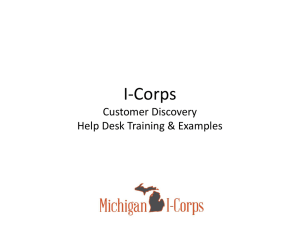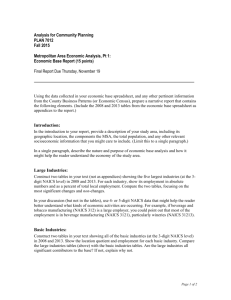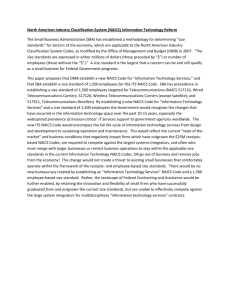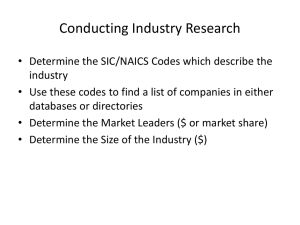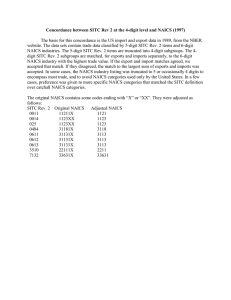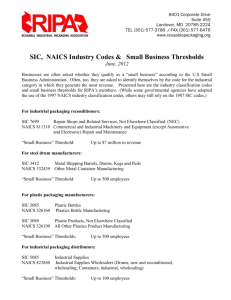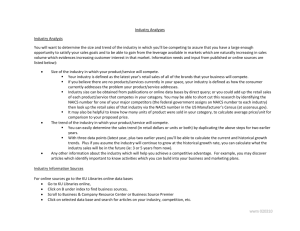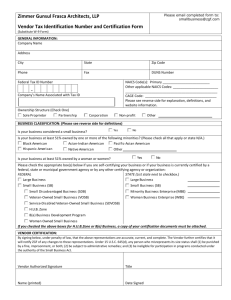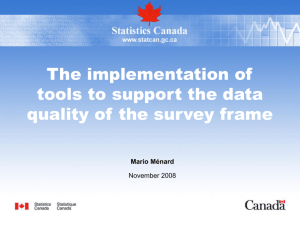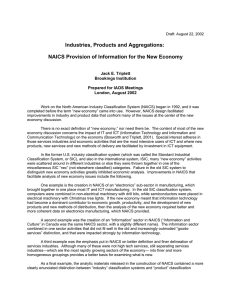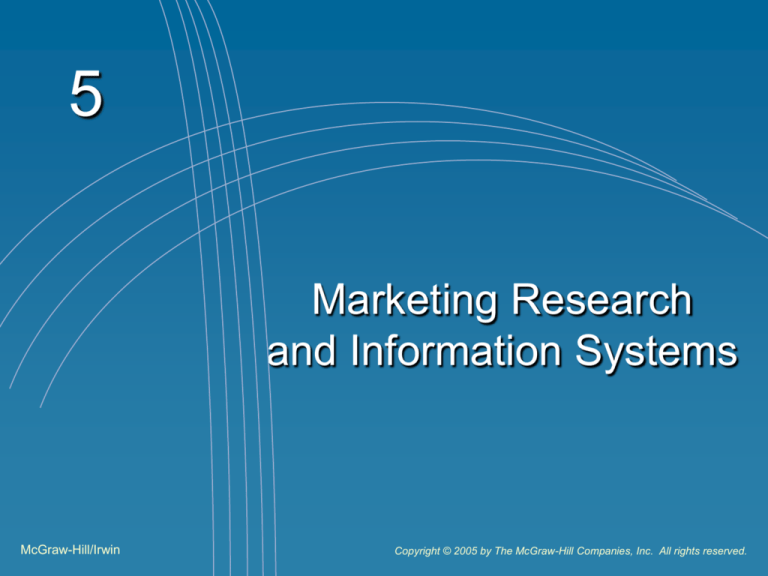
5
Marketing Research
and Information Systems
McGraw-Hill/Irwin
Copyright © 2005 by The McGraw-Hill Companies, Inc. All rights reserved.
Agenda
Differences between Business and
Consumer Marketing Research
The Business Marketing Research
Process
Developing Information Sources
Marketing Research Versus a Marketing
Information System
Reasons for Marketing Research and
Information Gathering
5-2
.
Differences between Business and
Consumer Marketing Research
Exhibit 5-1
Business
Consumer
Preparing to research
Complicated: Talk with as
many employees who have
contact with the customer as
possible, at all levels in the
organization. Then,
summarize findings and
talk to head managers to
finalize identification of the
problem.
Relatively simple: Talk to the
senior marketing, advertising or
product manager to define
problem.
Relationship with the
Customer
Close: Think about using
the research as a way to
improve or enhance
customer relations.
Relatively distant: Treat the
respondent with respect and
care but it is unlikely that the
Organization will ever have oneto-one contact with individual
respondents in the future.
5-3
.
Differences between Business and
Consumer Marketing Research
Exhibit 5-1
Business
Consumer
Respondent definition
and relationship
Different people in the same
company may contribute to
the decision to buy. So,
there may be multiple
respondents from each
customer business that
to be surveyed.
Individuals that are aware of a
category or brand, users of a
of a category or brand, those of
a particular demographic
criteria. Each respondent is
likely to be independent from all
other respondents.
Sample size
Small. Fairly limited in
total population and even
more so if within a defined
industry or NAICS
category.
Large. Dependent on category
under investigation but usually
more or less unlimited. There
are about 72.5 million U.S.
Households and over 250
million Americans.
5-4
.
Differences between Business and
Consumer Marketing Research
Exhibit 5-1
Research approach and
Methodology
Business
Surveys are often administered
personally (e.g., via one-on-one
interviews)
Consumer
Surveys are usually
administered impersonally
e.g., via mail, the Internet,
or phone)
5-5
The Business Marketing
Research Process
Define the Research Problem
Develop Research Objectives and Questions
Formulate a Research Plan (think about
cost/benefit)
•
•
•
Observational studies
Survey research
Experimental research
Execute Research Design
Prepare and Analyze Data
Prepare and Communicate Results (be aware
of “politics”)
5-6
Developing Information Sources
Secondary Data Sources
• Internal Sources - financial statements, research
reports, sales reports, customer letters
• External Sources - published marketing research
• Secondary Data on the Web - (but, as always,
consider the source)
• Government Sources - published marketing
research
NAICS
SEC
State Industrial Directories
• Companies listed by product, then grouped by location,
by NAICS code, and alphabetically
5-7
Developing Information Sources
Secondary Data Sources (con’t.)
• Commercial Sources - suppliers, banks,
consultants, ad agencies
Thomas Register of American Manufacturers, D&B
• Professional Publications - trade associations,
journals, shows
Association Membership Directories—lists members
alphabetically, by company, and sometimes by state or
county.
Trade publications
5-8
NAICS Codes
NAICS = North American Industrial Classification
System; replaced SIC (Standard Industrial Classification)
codes
Common for NAFTA countries
NAICS hierarchical structure:
XX
Industry sector
XXX
Industry subsector
XXXX
Industry group
XXXXX
Industry
XXXXXX
U.S., Canadian, or Mexican national
specific
http://www.naics.com/cgi-bin/search.pl
(continued)
5-9
NAICS Codes
Divides economy into 20 major industry sectors
(at two-digit level):
11 Agriculture, Forestry, Fishing,
and Hunting
21 Mining
22 Utilities
23 Construction
31–33 Manufacturing
42 Wholesale Trade
44–45 Retail Trade
48–49 Transportation
51 Information
52 Finance and Insurance
53 Real Estate, Renting,
and Leasing
54 Professional, Scientific, and Technical
services
55 Management of Companies and
Enterprises
56 Administrative and Support, Waste
Management, and Remediation Services
61 Education Services
62 Health Care and Social Assistance
71 Art, Entertainment, and Recreation
72 Accommodation and Food Services
81 Other services (except Public
Administration)
92 Public Administration
(continued)
5-10
NAICS Codes
Example of additional digits making the product more specific:
Sector
31–33 Manufacturing
Subsector
334
Industry group
3346
Manufacturing computer and
electronic products
Manufacturing of magnetic and optical
media
33461 Manufacturing of magnetic media
334611 Software reproduction
5-11
Developing Information Sources
Disadvantages of Secondary Data
• Recency of data
• Coverage of data (adequate for your
purposes?)
• Sample size (adequate?)
• Bias (by sponsor or objectives of original
survey)
• Data source
5-12
Developing Information Sources
Primary Data Sources
•
•
•
•
Personal Interviews
Telephone Surveys
Mail Surveys
Internet Surveys
5-13
5-5
5-14
Developing Information Sources
Disadvantages of Primary Data
• Expensive
• Time intensive
• Requires experimental design/survey design
skill
• Unwillingness (or inability) of respondent to
provide information
• Nonrepresentative, nonrespondent problem
5-15
Marketing Research Versus a
Marketing Information System
Marketing information system uses people, procedures,
hardware, and software to accumulate, integrate, and
disseminate important data through reports to key
marketing decision makers. In contrast, marketing
research is problem or project oriented.
Can also be defined as a system that scans and collects
data from the environment, makes use of data from
transactions and operations within the firm, and then
filters, organizes, and selects data before presenting it
as information to marketing management.
5-16
Exhibit 5-6
MARKETING
ENVIRONMENT
Information
MARKETING INFORMATION SYSTEM
Analytical
marketing
system
Internal
marketing
environment
Employees
Financial
resources
Marketing
intelligence
system
Data
organization
MARKETING
MANAGERS
Editing
Storage
Operating data
Marketing
External
marketing
environment
Internal
reports
system
Customers
Competition
Government
Suppliers
Marketing
research
system
Key Marketing
Decision
Makers
Data analysis
Modeling and
simulation
Information
Report
generation and
dissemination
Routine
information
Nonroutine
information
5-17
Reasons for Business Marketing
Research and Information Gathering
Market Potential
• maximum total sales and profit potential of
existing and new products
Market-Share Analysis
• ratio of sales revenue of the firm to the total
sales revenue of all firms in the industry
Market Characteristics
• factors that identify buyers and potential
buyers
5-18
Reasons for Business Marketing
Research and Information Gathering
Sales Analysis
• a.k.a. microsales analysis
• measuring sales as they relate to customer
and product characteristics, geographic
region, order size, and price or discount class
Forecasting
• Estimates of amount a firm expects to sell
during a specific time period under specific
conditions and to specific segments
5-19
Reasons for Business Marketing
Research and Information Gathering
CRM and Database Development
• Customer Relationship Management—
an integrated software system which typically
includes:
Customer service and communication
Sales force automation
Campaign management
Business intelligence
5-20
The CRM Process
Exhibit 5-7 A Simple Flow Model of the Customer Relationship Management Process
Determine Current Level
of Customer Relationships
within the Firm
Leverage and Disseminate
Customer Information
throughout Firm
Establish Interaction with
Current Customer Base
Analyze Data for
Profitable/Unprofitable
Segments
Acquire and Capture
Customer Data Based on
Interactions
Adapted from: Hair, Bush & Ortinau,
Marketing Research Within a
Changing Information Environment,
2nd Ed. (2003), p. 128.
Use Technology to Store
and Integrate Customer
Data
5-21
Reasons for Business Marketing
Research and Information Gathering
Other Applications
•
•
•
•
•
•
•
•
Setting sales quotas
Setting sales territories
Pricing
Test-marketing audits
Business trends
New product acceptance
Advertising research
Competitive differences
5-22
Marketing Research Assignment:
A Second Chance
Scenario:
Clemson Electronics Inc. is a high-tech electronics
manufacturer that has designed a mobile, quickresponding device to measure and identify hazardous
waste in soils. Traditionally, soil samples are collected,
brought to a lab, and processed through a series of tests
by a trained chemist. The new device is brought to the site,
requires no special training, and can quickly provide an
accurate analysis. The general manager has assigned you
to develop information upon which strategic planning will
be based.
How would you respond?
5-23

